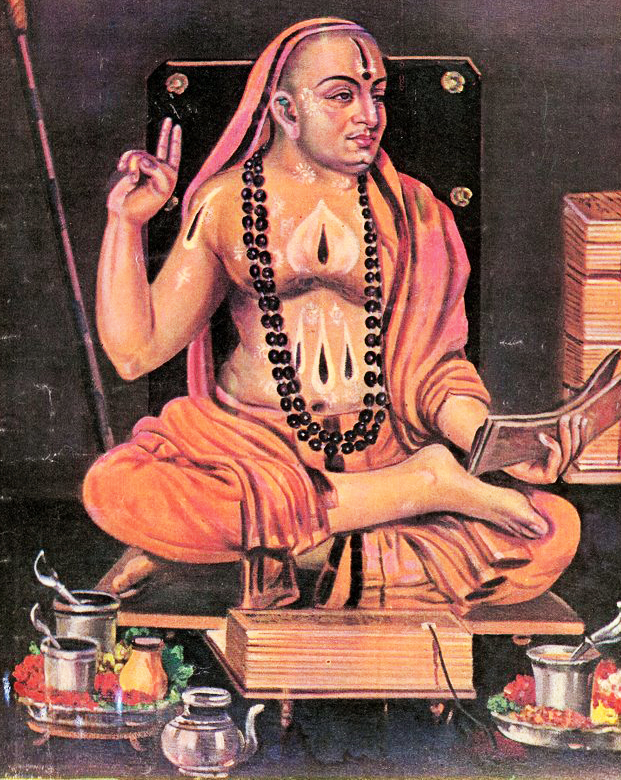Step 20
Mudra dharne
Applying mudra
Mudra
dharane is vaishnava chihne (symbol). Urdhva pundra dharane is vaidika chihne
(symbol of Bhagavath Bhakthi, astika). Just like how applying ashes ( basma) is
saiva chihne, similarly vaishnava chihne is applying mudra dharane.
As
a vaishnava after applying twelve urdhva pundras, should apply five mudras. In
five mudras four are the mudras of bhagavan ayudha (shanka, chakra, gada and
padma), and one is nama mudra – narayana akshara mudra.
Atleast
once or thrice in a year we should have tapta mudra dharane from our gurus. 1. Ashada
shuddha ekadashi. 2. Bhadrapada shuddha ekadashi 3. Karthika shuddha ekadashi.

Tapta Mudra dharne by Shri Vidyadeesha theertharu
For
GENTS
Chakra mudra
Think
of sudarshana maha jwala.
While
applying chakra mudra
Kamanthargatha dhinnamaka bharathy ramana mukya prananthargatha
himkara bhinna Sri krudholkaya nam:
Shank mudra
Panchajanya
gaja dwara ukta padaka sanjaya trahimam papinam gora samasaranava papinam.
While
applying shanka mudra
Prtvi namaka bharathy pathi apanathargatha ambranipati Sri maholkaya
nam:
Gada mudra
Bramanda
bhuvana aramba moolasthambo gadadharah kaumodhaki kareyasya tvam namami
gadadharam
Where
should we apply gada mudra
1.
Forehead
2.
Stomach
3.
Left side of heart
4. Below nama of left shoulder
While
applying gada mudra
Thing namaka bharathypathi vyanathargtha
lakshmipathi niddhana bhinna Shri virolkaya nam:
Padma mudra
Samara
bhaya bhithanam yoginaam abhaya pradaha padma hastena yo devo yogishantvam
namam yaham.
Where
should we apply padma mudra
1.
Heart
2.
Right
side of stomach
3.
Right side of heart
4.
Below nama of right side shoulder (2)
While
applying padma mudra
Vang namaka bharathypathi uthanathargatha dhakshinapathi
prasthavabhinna shri julkaya nam:

Narayana
mudra
This narayana mudra is powerful ashta akshara
naama mudra.
Narayana namastestu naama mrudhangitham naram
drishteva labathe mukthim kaandalo
bramhagathakah
While
applying narayana mudra
Vidhya namaka bharathypathi samanathargatha jayanthi pathi utgitha
bhinna Shrisahasrolkaya nam:
 |
| Jagath Guru Madvacharyaru with shanka chakradi chihnegalu |
Where
should we apply narayana mudre
Should
be applied on all the sides where ever we have kept the namas.
Then
wear tulasi mani/male praying “hey! Tulasi mani let Shri Krishna love me similar
to how he loves you. Let him care, shower blessings on me”. Can also wear
kamalaksha mala –
aksha
male namastubyam dadmasan krute sadaa padmavati prasadan twam dharana tho mahi.
Im
wear aksha mala/ kamalaksha mala why, because I should be loved by God.
Ye
kanta lagna tulasi -lalilaksha malaha
Ye
bahu moola parichinhita shanka chakraha
Ye
va lalata palake nasar urdhva pundraha
Ye
vaishnavaha buvana vasi pavitrayenti.
Ye
– whoever / whom so ever
Kanta
– neck
Bahu
– arms
Lalata-
forehead
One
who wear tulasi/kamalaksha mala in the neck, who has applied shanka, chakra, the
very own symbol of Shri Hari, in whose forehead urdhva pundra is seen so
clearly, these vaishnavas
will make the world pure. These are the lakshnas for viashnavas. If we see a
person wearing all these with Hari Bhakthi, our doshas will get vanished, if we
speak with such persons our vak(speaking) doshas will vanish, if we stay with
them all our sins get vanishes.
Who
are vaishnavs? The one who accepts Shri Hari. Who does Vishnu Bhakthi. He is
sarvaswami, sarvapraritha, sarvagnya, swathanthra, gunapurna…. If one say I have full of bhakthi inside, I don’t
like to wear all this and make a show off, then its of no use. These has to be
worn, both bhakthi and these (*these and those refers to wearing tulasi mani,
urdhva pundra and mudras) chihne’s goes hand in hand.
Vishnu
likes tulasi mani and kamalaksha mani through Lord Lakshmi.
It
makes us pure (pavitra).
After
mudra dharne we should start to do our nitya karma. Achamana, sandyavandhana, Narayana
ashtakshara mantra, hamsa mandira samarpana,jeeva panchakashara mantra japa (om
shivaya nam: om – should pray rudra devaru as he is manoabhimani and will give
us tatvagyana.) etc. As we all know Akrura while bringing back Krishna from
Vridhavan, did Sandyavandhana even tough Krishna was sitting just near him in
the cart. Which says the importance of Sandhyavandhana, and nothing can stop
it.
On the crisp:
While
applying namas think of Shri Hari’s
1.
Krudholka
2.
Maholka
3.
Virolka
4.
Julka
5.
Sahasrolka
And also think of the mukya prana devaru who are
respective authorities of Shri Hari’s
forms
1.
Prana
2.
Vyana
3.
Apana
4.
Udhana
5.
Samana
While
applying chakra mudra
Kamanthargatha dhinnamaka bharathy ramana mukya prananthargatha
himkara bhinna Sri krudholkaya nam:
While
applying shanka mudra
Prtvi namaka bharathy pathi apanathargatha ambranipati Sri maholkaya
nam:
While
applying gada mudra
Thing namaka bharathypathi vyanathargtha
lakshmipathi niddhana bhinna Shri virolkaya nam:
While
applying padma mudra
Vang namaka bharathypathi uthanathargatha dhakshinapathi
prasthavabhinna shri julkaya nam:
While
applying narayana mudra
Vidhya namaka bharathypathi samanathargatha jayanthi pathi utgitha
bhinna Shrisahasrolkaya nam:
As
shri Vyasarajaru has told “kamalanabha chihneyanu dharasikondu merayiro. Yamana
bhattaru nodi anji adagi hoguvaro. Krishna Krishna Krishna endu mooru bari
neneyiro ”
So
just applying the urdhva pundra, mudra chihnes are only not enough, instead
we should think of Shri Krishna , we should keep on repeating his again again
and again as much as possible.
|




